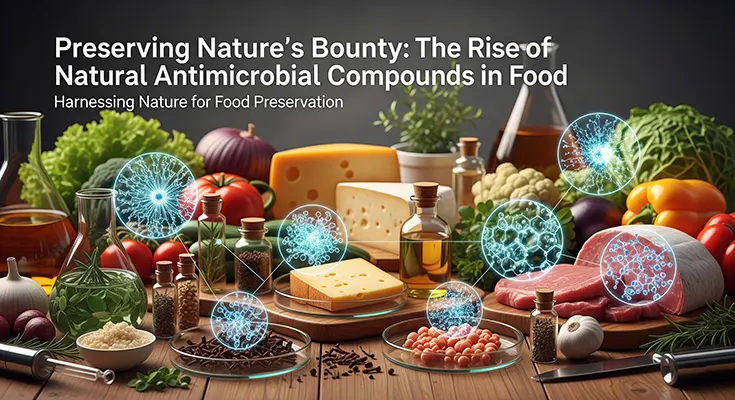In an era of growing consumer demand for “clean label” products and a move away from synthetic additives, the food industry is turning to an ancient-yet-innovative solution: food preservation using natural antimicrobial compounds. These powerful substances, derived from plants, animals, and microorganisms, are proving to be a safe, effective, and sustainable way to extend the shelf life of food, reduce waste, and enhance food safety without compromising flavor or quality.
The Challenge of Spoilage
Food spoilage is a complex process primarily caused by the growth of microorganisms such as bacteria, yeasts, and molds. These microbes break down the food’s components, leading to undesirable changes in texture, taste, and smell. Traditional preservation methods, like high heat, salting, or chemical preservatives, have long been used to combat this, but they can sometimes degrade nutritional content or be perceived as “unnatural” by consumers. This has paved the way for a new generation of bio-preservation techniques that harness the power of natural compounds.
A Diverse Arsenal from Nature’s Pantry
Natural antimicrobial compounds work by disrupting the cellular functions of microbes, effectively halting their growth and preventing spoilage. They can be broadly categorized based on their source.
1. Plant-Derived Compounds: The Power of Herbs and Spices
For centuries, herbs and spices have been used in cooking for more than just flavor; many contain powerful bioactive compounds that act as natural preservatives.
- Essential Oils: Volatile liquids extracted from plants like oregano, thyme, rosemary, and cinnamon contain a high concentration of antimicrobial compounds. For example, oregano and thyme oils are rich in carvacrol and thymol, which disrupt bacterial cell membranes, causing them to leak and die. These essential oils are highly effective against a broad spectrum of pathogens and can be incorporated directly into food products or used in active packaging.
- Phenolic Compounds: Found in a wide range of plants, including grape seeds, olives, and green tea, these compounds have both antioxidant and antimicrobial properties. They inhibit microbial growth and prevent the oxidation that can lead to rancidity in fats.
- Garlic and Onions: These common kitchen staples contain allicin and other sulfur compounds that have a strong inhibitory effect on the growth of many microorganisms.
2. Microbe-Derived Compounds: The Biopreservation Revolution
Some microorganisms produce their own antimicrobial peptides to compete for resources, and these can be harnessed for food preservation.
- Bacteriocins: These are small, protein-based compounds produced by bacteria. Nisin, produced by the bacterium Lactococcus lactis (used in cheese production), is one of the most well-known and widely used natural preservatives. It is particularly effective against Gram-positive bacteria, including dangerous pathogens like Listeria monocytogenes and spore-forming bacteria that can survive heat treatments. Nisin works by forming pores in the microbial cell membrane, causing cell death.
- Natamycin: Produced by the bacterium Streptomyces natalensis, this is a powerful antifungal agent. It is often used to coat the surface of cheeses and fermented sausages to prevent the growth of molds and yeasts, which are common causes of spoilage. Its stability across a wide pH range makes it a versatile tool for preserving a variety of products.
3. Animal-Derived Compounds: Enzymes and Proteins
Nature’s own defense systems also provide valuable antimicrobial agents.
- Lysozyme: This enzyme, found in egg whites and mammalian milk, works by breaking down the cell walls of bacteria, particularly Gram-positive ones. It is often used in semi-hard cheeses to prevent “late blowing,” a defect caused by gas-producing bacteria.
- Lactoferrin: An iron-binding protein found in milk, lactoferrin inhibits microbial growth by essentially starving bacteria of the iron they need to multiply.
The Future of Food Preservation
The shift toward natural antimicrobial compounds represents a significant paradigm change in the food industry. By moving away from a reliance on synthetic chemicals, food producers can meet consumer demand for healthier, more natural products. As research continues to uncover new compounds and synergistic applications—where two or more natural antimicrobials work together for enhanced effect—this field is poised to revolutionize not only food safety and quality but also the global food supply chain, offering a more sustainable and wholesome approach to feeding the world.





